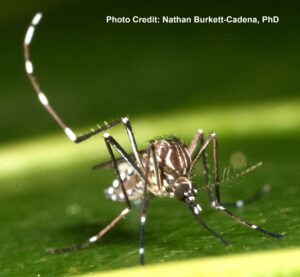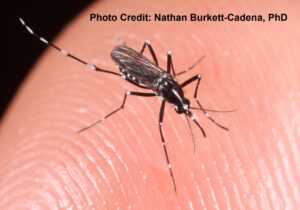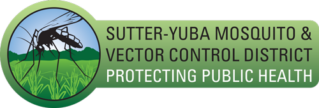The Aedes aegypti mosquito has been progressing northward through California, and has been found in both Sutter and Yuba Counties. The first detection was made in August of 2020 in Yuba City, California in Sutter County. A detection was made in July 2023 in Olivehurst, California in Yuba County. The Sutter-Yuba Mosquito & Vector Control District is implementing its Invasive Aedes Response Plan to define the scope of these infestations and to mitigate or eradicate these mosquitoes. Staff will be conducting surveilance in these areas using specialized mosquito traps. Once the scope of the infestations are defined, the District will begin control measures.
Three invasive mosquito species have been detected in quite a few California counties. More photos of these species can be found by performing an image search online.
Yellow Fever Mosquito

Aedes aegypti is a tropical and subtropical mosquito species that is commonly identified by the lyre shaped marking on its thorax (back). It can be found in many parts of the world and was first detected in California in 2013 in Fresno, Madera, Santa Clara and San Mateo Counties, and was found in Los Angeles County in 2014. In 2019, Aedes aegypti was discovered in Stanislaus, San Joaquin, Placer and Sacramento counties. In August 2020 Aedes aegypti was confirmed in Sutter County. In July 2023 confirmation was made in Yuba County. This mosquito species is capable of transmitting Yellow Fever, Dengue, Chikungunya and Zika viruses to people, only if these diseases are present in the local human population already.
Asian Tiger Mosquito

Aedes albopictus is a small, dark mosquito with a white stripe behind their head and banded legs. They were first found in El Monte in Los Angeles County in 2011. It has since spread to three neighboring counties, as well as Shasta county in northern California in 2020. It has the capability of transmitting Dengue, West Nile Virus, Zika, Chikungunya, Lacrosse and potentially Yellow Fever viruses to humans. They are strongly attracted to humans, but will bite and feed on cats, dogs, and many other mammals.
Australian Backyard Mosquito
The third invasive mosquito is called Aedes notoscriptus and is very common in Australia. It was first found in Montebello and Monterey Park in Los Angeles County in 2014. In Australia this mosquito transmits Murray Valley Encephalitis. Little is known about this mosquito’s role in transmitting other mosquito-borne diseases to people, but it is capable of transmitting Dog Heartworm. Aedes aegypti and Aedes albopictus are also capable of transmitting Dog Heartworm. Please remember, this mosquito species has not been found in our area yet, but have the potential to come here at anytime in the future.
Identification for these invasive mosquitoes
- Small black and white striped mosquitoes (about 1/4 inch long)
- Most likely, they traveled to California as dormant eggs in imported tires, or as eggs, larvae or adult mosquitoes hitch-hiking rides on planes, ships, cars, trucks, shipping containers or other vehicles
- They are aggressive day biting mosquitoes
- Eggs are laid in ornamental water fountains, potted plants, pet water dishes, or plastic and metal containers in piles of garbage
- Even if the mosquito eggs dry out, the eggs can survive for many months and will hatch when coming into contact with water once again
- They will breed inside homes or offices in containers of water such as pet dishes, potted plants and saucers and indoor fountains
- The eggs of these mosquitoes will look like small black seeds or specks (see photo below)
Yellow Fever, Dengue, Chikungunya and Zika are not locally transmitted in California as of August 2021, but the mosquitoes that can spread these diseases are now found in parts of California including Sutter County. Infected people traveling from other parts of the world, or returning from vaction or business could bring these diseases to California. Mosquitoes transmit these diseases to people in a cycle – mosquitoes pick up viruses by biting infected people, then transmit these diseases to other people by biting them. In this way, humans are serving as reservoirs (hosts) and invasive mosquitoes are carriers (vectors) of these diseases. Mosquito and vector control districts in the affected areas of California are aggressively trying to control these mosquitoes using a multitude of integrated pest management tools. Methods used to control the eggs, larval, pupal and adult stages are being conducted in these areas.
To stop the spread of these mosquitoes, residents have a critical role:
1) Call your local mosquito and vector control district if you see or are bitten by small black and white mosquitoes during the day! They are very sneaky and aggressive, and will easily follow you indoors. Many people will recognize them as something new!
2) Drain and Dump all standing and stagnant water around your home and property. Get rid of any unnecessary items that could hold water. Keep pet dishes, bird baths and kiddy pools scrubbed, clean and fresh. These mosquitoes are capable of laying thousands of eggs in just one container in your yard that holds water! They commonly lay their eggs in saucers placed under potted plants (fill saucers with sand), clogged rain gutters, standing water under houses, rain barrels and buckets, around leaky faucets, abandoned swimming pools and hot tubs, ornamental ponds, fish ponds, unsealed septic tanks and even trash piles. Keep your windows and doors properly screened.
3) Use Insect Repellents containing EPA registered active ingredients like DEET, Picaridin or oil of lemon eucalyptus to avoid all mosquito bites.
4) Do Not Transport or share plant stems that have been rooted in water, as these containers could be contaminated with mosquito eggs – example: lucky bamboo. Do not transport potted plants and the saucers used with them as these may also be contaminated with mosquito eggs.
To learn more, please visit the following websites:
California invasive Aedes distribution map: https://www.cdph.ca.gov/Programs/CID/DCDC/CDPH%20Document%20Library/AedesDistributionMap.pdf
Invasive Aedes Brochure: https://www.cdph.ca.gov/Programs/CID/DCDC/CDPH%20Document%20Library/InvasiveMosquitoesBrochure.pdf
Aedes aegypti Factsheet: https://www.cdph.ca.gov/Programs/CID/DCDC/CDPH%20Document%20Library/AedesaegyptiFactSheet.pdf
California West Nile Virus Website: www.WestNile.ca.gov
California Department of Public Health, Division of Communicable Disease Control: www.cdph.ca.gov
Centers for Disease Control and Prevention, Division of Vector-Borne Diseases (DVBD): www.cdc.gov
Center for Invasive Species Research (CISR): cisr.ucr.edu
United States Geological Survey (USGS): usgs.gov
